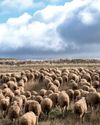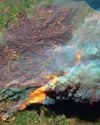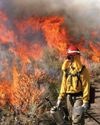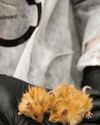Try GOLD - Free
Who's Your Cousin?
Muse Science Magazine for Kids
|April 2024
The great apes are among the most popular animals in most zoos. Their actions, facial expressions, and family life remind us so much of ourselves. Have you ever wondered, though, how we might look to them?

A modern, statistically based system of classification called cladistics reveals a surprising possibility: Not only are humans apes, but we are more closely related to chimpanzees than chimpanzees are to orangutans or gorillas. In other words, the chimpanzees’ closest living relatives are—us! A gorilla, looking past our culture and technology, might see us humans as just another type of chimpanzee.

Cladistics is a mathematical representation of a simple idea—that all living things are related. The more they are related, the more recently they had a common ancestor. These relationships are expressed in diagrams called cladograms.
The simplest cladogram links two living things—you and a chimpanzee, for instance. The diagram doesn’t seem to display much information, as there’s only one way to draw it. You and a chimpanzee have a lot in common, sharing among other traits four limbs, hair, a big brain, and almost 99 percent of your DNA. In other ways, you and a chimpanzee are different. That’s why you appear on separate branches of the cladogram, after all!

The interesting questions arise when we add a third living thing to the cladogram—let’s say a gorilla. There are three different ways to draw this relationship. How do we decide among them?
This story is from the April 2024 edition of Muse Science Magazine for Kids.
Subscribe to Magzter GOLD to access thousands of curated premium stories, and 10,000+ magazines and newspapers.
Already a subscriber? Sign In
MORE STORIES FROM Muse Science Magazine for Kids

Muse Science Magazine for Kids
ANIMAL FIREFIGHTER TO THE RESCUE
Can animals help manage the risks of deadly wildfires?
3 mins
Muse July 2025: The Story Behind Wildfires

Muse Science Magazine for Kids
FIRE DANGER
WHY THE RISK OF WILDFIRES KEEPS GROWING
4 mins
Muse July 2025: The Story Behind Wildfires

Muse Science Magazine for Kids
The Miller NEW Normal
WHAT TODAY’S WILDFIRES TELL US ABOUT OUR FUTURE
8 mins
Muse July 2025: The Story Behind Wildfires

Muse Science Magazine for Kids
WOMEN AND FIREFIGHTING: A GOOD FIT
Jessica Gardetto is a firefighter. Her father was, too. “I grew up with my dad coming home smelling like wildfire and covered in soot,” she says.
1 min
Muse July 2025: The Story Behind Wildfires

Muse Science Magazine for Kids
What is happening on your fingertips when they get all wrinkly in a hot tub?
—Felix G., age 10, Montana
1 mins
Muse July 2025: The Story Behind Wildfires

Muse Science Magazine for Kids
WHEN the SMOKE CLEARS
THE LINGERING EFFECTS OF THE RECENT PACIFIC PALISADES AND ALTADENA EATON FIRES
6 mins
Muse July 2025: The Story Behind Wildfires

Muse Science Magazine for Kids
PICKING TEAMS
Keep it fair with a strategy that relies on geometry.
2 mins
Muse July 2025: The Story Behind Wildfires

Muse Science Magazine for Kids
SHAN CAMMACK
WILDLIFE BIOLOGIST AND FIRE SAFETY OFFICER
3 mins
Muse July 2025: The Story Behind Wildfires

Muse Science Magazine for Kids
Scientists Create Mice With Woolly Mammoth-Like Fur
RESEARCHERS AT A COMPANY IN TEXAS ARE WORKING TO CREATE A LIVING ANIMAL THAT RESEMBLES THE EXTINCT WOOLLY MAMMOTH. Recently, they produced mice with traits of the large mammal. The mice all have coats with mammoth-like fur, and some of the small mammals also have genes that help them store fat. Both features would help the animals survive in the cold Arctic, where the woolly mammoth once lived.
1 min
Muse July 2025: The Story Behind Wildfires

Muse Science Magazine for Kids
Cool Sunshade Added to the Nancy Roman Space Telescope
THE NANCY ROMAN SPACE TELESCOPE IS A NEW TELESCOPE THAT NASA IS BUILDING AND WILL LAUNCH INTO SPACE, LIKELY IN EARLY 2027.
1 min
Muse July 2025: The Story Behind Wildfires
Listen
Translate
Change font size
